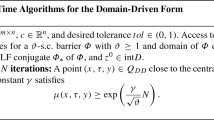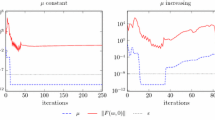Abstract
The alternating direction method of multipliers is a powerful operator splitting technique for solving structured optimization problems. For convex optimization problems, it is well known that the algorithm generates iterates that converge to a solution, provided that it exists. If a solution does not exist, then the iterates diverge. Nevertheless, we show that they yield conclusive information regarding problem infeasibility for optimization problems with linear or quadratic objective functions and conic constraints, which includes quadratic, second-order cone, and semidefinite programs. In particular, we show that in the limit the iterates either satisfy a set of first-order optimality conditions or produce a certificate of either primal or dual infeasibility. Based on these results, we propose termination criteria for detecting primal and dual infeasibility.







Similar content being viewed by others
References
Parikh, N., Boyd, S.: Proximal algorithms. Found. Trends Optim. 1(3), 123–231 (2013). https://doi.org/10.1561/2400000003
Bauschke, H.H., Borwein, J.M.: On projection algorithms for solving convex feasibility problems. SIAM Rev. 38(3), 367–426 (1996). https://doi.org/10.1137/S0036144593251710
Bauschke, H.H., Combettes, P.L., Luke, D.R.: Finding best approximation pairs relative to two closed convex sets in Hilbert spaces. J. Approx. Theory 127(2), 178–192 (2004). https://doi.org/10.1016/j.jat.2004.02.006
Boley, D.: Local linear convergence of the alternating direction method of multipliers on quadratic or linear programs. SIAM J. Optim. 23(4), 2183–2207 (2013). https://doi.org/10.1137/120878951
O’Donoghue, B., Chu, E., Parikh, N., Boyd, S.: Conic optimization via operator splitting and homogeneous self-dual embedding. J. Optim. Theory Appl. 169(3), 1042–1068 (2016). https://doi.org/10.1007/s10957-016-0892-3
Zheng, Y., Fantuzzi, G., Papachristodoulou, A., Goulart, P., Wynn, A.: Chordal decomposition in operator-splitting methods for sparse semidefinite programs. Math. Program. (2019). https://doi.org/10.1007/s10107-019-01366-3
O’Donoghue, B., Stathopoulos, G., Boyd, S.: A splitting method for optimal control. IEEE Trans. Control Syst. Technol. 21(6), 2432–2442 (2013). https://doi.org/10.1109/TCST.2012.2231960
Jerez, J., Goulart, P., Richter, S., Constantinides, G., Kerrigan, E., Morari, M.: Embedded online optimization for model predictive control at megahertz rates. IEEE Trans. Autom. Control 59(12), 3238–3251 (2014). https://doi.org/10.1109/TAC.2014.2351991
Banjac, G., Stellato, B., Moehle, N., Goulart, P., Bemporad, A., Boyd, S.: Embedded code generation using the OSQP solver. In: IEEE Conference on Decision and Control (CDC), pp. 1906–1911 (2017). https://doi.org/10.1109/CDC.2017.8263928
Beck, A., Teboulle, M.: Fast gradient-based algorithms for constrained total variation image denoising and deblurring problems. IEEE Trans. Image Process. 18(11), 2419–2434 (2009). https://doi.org/10.1109/TIP.2009.2028250
Combettes, P.L., Wajs, V.R.: Signal recovery by proximal forward-backward splitting. Multiscale Model. Simul. 4(4), 1168–1200 (2005). https://doi.org/10.1137/050626090
Combettes, P.L., Pesquet, J.C.: Proximal splitting methods in signal processing. Springer Optim. Appl. 49, 185–212 (2011). https://doi.org/10.1007/978-1-4419-9569-8_10
Boyd, S., Parikh, N., Chu, E., Peleato, B., Eckstein, J.: Distributed optimization and statistical learning via the alternating direction method of multipliers. Found. Trends Mach. Learn. 3(1), 1–122 (2011). https://doi.org/10.1561/2200000016
Stathopoulos, G., Shukla, H., Szucs, A., Pu, Y., Jones, C.: Operator splitting methods in control. Found. Trends Syst. Control 3(3), 249–362 (2016). https://doi.org/10.1561/2600000008
Bauschke, H.H., Combettes, P.L.: Convex Analysis and Monotone Operator Theory in Hilbert Spaces. Springer, New York (2011). https://doi.org/10.1007/978-1-4419-9467-7
Ghadimi, E., Teixeira, A., Shames, I., Johansson, M.: Optimal parameter selection for the alternating direction method of multipliers (ADMM): quadratic problems. IEEE Trans. Autom. Control 60(3), 644–658 (2015). https://doi.org/10.1109/TAC.2014.2354892
Giselsson, P., Boyd, S.: Linear convergence and metric selection for Douglas–Rachford splitting and ADMM. IEEE Trans. Autom. Control 62(2), 532–544 (2017). https://doi.org/10.1109/TAC.2016.2564160
Banjac, G., Goulart, P.: Tight global linear convergence rate bounds for operator splitting methods. IEEE Trans. Autom. Control 63(12), 4126–4139 (2018). https://doi.org/10.1109/TAC.2018.2808442
Naik, V.V., Bemporad, A.: Embedded mixed-integer quadratic optimization using accelerated dual gradient projection. In: IFAC World Congress, pp. 10,723–10,728 (2017). https://doi.org/10.1016/j.ifacol.2017.08.2235
Eckstein, J., Bertsekas, D.P.: On the Douglas–Rachford splitting method and the proximal point algorithm for maximal monotone operators. Math. Program. 55(1), 293–318 (1992). https://doi.org/10.1007/BF01581204
Bauschke, H.H., Dao, M.N., Moursi, W.M.: The Douglas–Rachford algorithm in the affine-convex case. Oper. Res. Lett. 44(3), 379–382 (2016). https://doi.org/10.1016/j.orl.2016.03.010
Bauschke, H.H., Moursi, W.M.: The Douglas–Rachford algorithm for two (not necessarily intersecting) affine subspaces. SIAM J. Optim. 26(2), 968–985 (2016). https://doi.org/10.1137/15M1016989
Bauschke, H.H., Moursi, W.M.: On the Douglas–Rachford algorithm. Math. Program. 164(1), 263–284 (2017). https://doi.org/10.1007/s10107-016-1086-3
Moursi, W.M.: The Douglas–Rachford operator in the possibly inconsistent case: static properties and dynamic behaviour. Ph.D. thesis, University of British Columbia (2016). https://doi.org/10.14288/1.0340501
Raghunathan, A.U., Di Cairano, S.: Infeasibility detection in alternating direction method of multipliers for convex quadratic programs. In: IEEE Conference on Decision and Control (CDC), pp. 5819–5824 (2014). https://doi.org/10.1109/CDC.2014.7040300
Toh, K.C.: An inexact primal-dual path following algorithm for convex quadratic SDP. Math. Program. 112(1), 221–254 (2008). https://doi.org/10.1007/s10107-006-0088-y
Henrion, D., Malick, J.: Projection Methods in Conic Optimization, pp. 565–600. Springer, New York (2012). https://doi.org/10.1007/978-1-4614-0769-0_20
Stellato, B., Banjac, G., Goulart, P., Bemporad, A., Boyd, S.: OSQP: an operator splitting solver for quadratic programs. arXiv:1711.08013 (2018)
Rockafellar, R.T., Wets, R.J.B.: Variational Analysis. Grundlehren der mathematischen Wissenschaften. Springer, New York (1998). https://doi.org/10.1007/978-3-642-02431-3
Lourenço, B.F., Muramatsu, M., Tsuchiya, T.: Weak infeasibility in second order cone programming. Optim. Lett. 10(8), 1743–1755 (2016). https://doi.org/10.1007/s11590-015-0982-4
Rockafellar, R.T.: Convex Analysis. Princeton University Press, Princeton (1970)
Boyd, S., Vandenberghe, L.: Convex Optim. Cambridge University Press, Cambridge (2004). https://doi.org/10.1017/CBO9780511804441
Gabay, D.: Applications of the method of multipliers to variational inequalities. Stud. Math. Appl. 15((C)), 299–331 (1983). https://doi.org/10.1016/S0168-2024(08)70034-1
Giselsson, P., Fält, M., Boyd, S.: Line search for averaged operator iteration. In: IEEE Conference on Decision and Control (CDC), pp. 1015–1022 (2016). https://doi.org/10.1109/CDC.2016.7798401
Lions, P., Mercier, B.: Splitting algorithms for the sum of two nonlinear operators. SIAM J. Numer. Anal. 16(6), 964–979 (1979). https://doi.org/10.1137/0716071
Pazy, A.: Asymptotic behavior of contractions in Hilbert space. Isr. J. Math. 9(2), 235–240 (1971). https://doi.org/10.1007/BF02771588
Baillon, J.B., Bruck, R.E., Reich, S.: On the asymptotic behavior of nonexpansive mappings and semigroups in Banach spaces. Houst. J. Math. 4(1), 1–9 (1978)
Borchers, B.: SDPLIB 1.2, a library of semidefinite programming test problems. Optim. Methods Softw. 11(1), 683–690 (1999). https://doi.org/10.1080/10556789908805769
Ramana, M.V.: An exact duality theory for semidefinite programming and its complexity implications. Math. Program. 77(1), 129–162 (1997). https://doi.org/10.1007/BF02614433
Acknowledgements
We are grateful to Walaa Moursi for helpful comments and pointing out additional references. This work was supported by the People Programme (Marie Curie Actions) of the European Union Seventh Framework Programme (FP7/2007–2013) under REA Grant Agreement No. 607957 (TEMPO).
Author information
Authors and Affiliations
Corresponding author
Additional information
Communicated by Jalal M. Fadili.
Publisher's Note
Springer Nature remains neutral with regard to jurisdictional claims in published maps and institutional affiliations.
Appendix A: Supporting Results
Appendix A: Supporting Results
Lemma A.1
The first-order optimality conditions for problem (2) are conditions (3).
Proof
We first rewrite problem (2) in the form
and then form its Lagrangian
Provided that the problem satisfies certain constraint qualification [15, Cor. 26.3], its solution can be characterized via a saddle point of (35). Therefore, the first-order optimality conditions can be written as [29, Ex. 11.52]
\(\square \)
Lemma A.2
The dual of problem (1) is given by problem (4).
Proof
The dual function can be derived from the Lagrangian (35) as follows:
Note that the minimum of the Lagrangian over x is attained when \(Px + A^Ty + q = 0\), and the second term in the last line is \(S_{\mathcal {C}}(y)\). The dual problem, defined as the problem of maximizing the dual function, can then be written in the form (4), where the conic constraint on y is just the restriction of y to the domain of \(S_{\mathcal {C}}\) [31, p.112 and Cor. 14.2.1]. \(\square \)
Lemma A.3
For any vectors \(v\in \mathbb {R}^n\), \(b\in \mathbb {R}^n\) and a nonempty, closed, and convex cone \(\mathcal {K}\subseteq \mathbb {R}^n\),
-
(i)
\({\Pi }_{\mathcal {K}_b}(v) = b + {\Pi }_{\mathcal {K}}(v - b)\).
-
(ii)
\(({{\,\mathrm{Id}\,}}- {\Pi }_{\mathcal {K}_b})(v) = {\Pi }_{{\mathcal {K}}^{\circ }}(v - b)\).
-
(iii)
\(\left\langle {{\Pi }_{\mathcal {K}_b}(v)},{({{\,\mathrm{Id}\,}}- {\Pi }_{\mathcal {K}_b})(v)}\right\rangle = \left\langle {b},{{\Pi }_{{\mathcal {K}}^{\circ }}(v - b)}\right\rangle \).
-
(iv)
\(\left\langle {{\Pi }_{\mathcal {K}}(v)},{v}\right\rangle = ||{\Pi }_{\mathcal {K}}(v)||^2\).
-
(v)
\(S_{\mathcal {K}_b} ( {\Pi }_{{\mathcal {K}}^{\circ }}(v) ) = \left\langle {b},{{\Pi }_{{\mathcal {K}}^{\circ }}(v)}\right\rangle \).
Proof
Part (i) is from [15, Prop. 28.1(i)].
-
(ii)
From part (i), we have
$$\begin{aligned} ({{\,\mathrm{Id}\,}}- {\Pi }_{\mathcal {K}_b})(v) = v - b - {\Pi }_{\mathcal {K}}(v - b) = {\Pi }_{{\mathcal {K}}^{\circ }}(v - b), \end{aligned}$$where the second equality follows from the Moreau decomposition [15, Thm. 6.29].
-
(iii)
Follows directly from parts (i) and (ii), and the Moreau decomposition.
-
(iv)
From the Moreau decomposition, we have
$$\begin{aligned} \left\langle {{\Pi }_{\mathcal {K}}(v)},{v}\right\rangle = \left\langle {{\Pi }_{\mathcal {K}}(v)},{{\Pi }_{\mathcal {K}}(v) + {\Pi }_{{\mathcal {K}}^{\circ }}(v)}\right\rangle = ||{\Pi }_{\mathcal {K}}(v)||^2. \end{aligned}$$\(\square \)
-
(v)
Since the support function of \(\mathcal {K}\) evaluated at any point in \({\mathcal {K}}^{\circ }\) is zero, we have
$$\begin{aligned} S_{\mathcal {K}_b} ( {\Pi }_{{\mathcal {K}}^{\circ }}(v) ) = \left\langle {b},{{\Pi }_{{\mathcal {K}}^{\circ }}(v)}\right\rangle + S_{\mathcal {K}} ( {\Pi }_{{\mathcal {K}}^{\circ }}(v) ) = \left\langle {b},{{\Pi }_{{\mathcal {K}}^{\circ }}(v)}\right\rangle . \end{aligned}$$
Lemma A.4
Suppose that \(\mathcal {K}\subseteq \mathbb {R}^n\) is a nonempty, closed, and convex cone and for some sequence \(\lbrace {v^k} \rbrace _{k\in {\mathbb {N}}}\), where \(v^k\in \mathbb {R}^n\), we denote by \(\delta v :=\lim _{k\rightarrow \infty }\tfrac{1}{k}v^k\), assuming that the limit exists. Then for any \(b\in \mathbb {R}^n\),
Proof
Write the limit as
where the first equality uses Lemma A.3(i) and the second and third follow from the positive homogeneity [15, Prop. 28.22] and continuity [15, Prop. 4.8] of \({\Pi }_{\mathcal {K}}\), respectively. \(\square \)
Lemma A.5
Suppose that \(\mathcal {B}\subseteq \mathbb {R}^n\) is a nonempty, convex, and compact set, and for some sequence \(\lbrace {v^k} \rbrace _{k\in {\mathbb {N}}}\), where \(v^k\in \mathbb {R}^n\), we denote by \(\delta v :=\lim _{k\rightarrow \infty }\tfrac{1}{k}v^k\), assuming that the limit exists. Then
Proof
Let \(z^k :={\Pi }_{\mathcal {B}}(v^k)\). We have the following inclusion [15, Prop. 6.46]
which, due to [15, Thm. 16.23], and the facts that \(S_{\mathcal {B}}\) is the Fenchel conjugate of \(\mathcal {I}_\mathcal {B}\) and \(N_{\mathcal {B}}\) is the subdifferential of \(\mathcal {I}_\mathcal {B}\), is equivalent to
Taking the limit of the identity above, we obtain
where the second equality follows from the continuity of \(S_{\mathcal {B}}\) [15, Ex. 11.2] and the third from the compactness of \(\mathcal {B}\). Since \(\lbrace {z^k} \rbrace _{k\in {\mathbb {N}}}\) remains in the compact set \(\mathcal {B}\), we can derive the following relation from (36):
where the third row follows from the triangle and Cauchy-Schwarz inequalities and the fourth from the compactness of \(\mathcal {B}\). Finally, we can derive the following identity from (36):
This concludes the proof. \(\square \)
Rights and permissions
About this article
Cite this article
Banjac, G., Goulart, P., Stellato, B. et al. Infeasibility Detection in the Alternating Direction Method of Multipliers for Convex Optimization. J Optim Theory Appl 183, 490–519 (2019). https://doi.org/10.1007/s10957-019-01575-y
Received:
Accepted:
Published:
Issue Date:
DOI: https://doi.org/10.1007/s10957-019-01575-y
Keywords
- Convex optimization
- Infeasibility detection
- Alternating direction method of multipliers
- Conic programming




